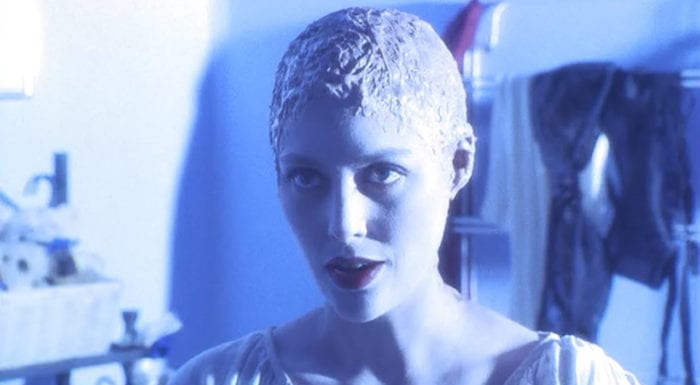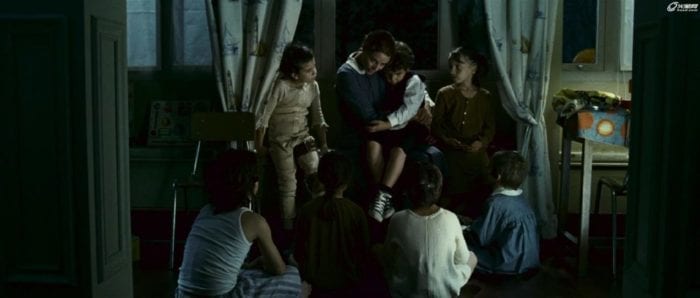The final girl has been a staple of horror cinema since the trope was canonized in the mid-1980s, but exists as part of a progression from the final couples of earlier horror cinema and has continued to evolve in the years since. As horror cinema has listed in an increasingly post-modern direction ever since tropes like the ‘final girl’ became so recognizable, and became so often parodied, horror cinema has increasingly offered examples that deconstruct the archetype in a critical fashion. Much as many of the most iconic horror antagonists have come to be treated increasingly as antiheroes—they do after all often exist to ritualistically punish those guilty of social transgressions—the final girls have also undergone an evolution, with an increasingly ambivalent relationship towards the horrific presences they encounter. Often, the horrifying influences represent a need that their character arc pushes them into internalizing, though often as a bargain that comes with a hefty price.
There are familiar and obvious examples of this like Dani in Midsommar, whose ordeal is a manifestation of her need to cut emotional ties with an unsupportive partner, but in doing so finds herself pulled into a community of rigid social order, where the potential for violence will always be present. However, Dani is far from the only example of this more complex variant of final girls, whose survival depends not simply upon their resourcefulness or resilience, but their malleability and responsiveness to change. This malleability has taken many forms in recent years, sometimes representing a need for a change in social or familial engagement, an emotional need to find peace with inner trauma, and sometimes a moral mutability, embracing a darker path than the one laid out for them.
One of the earliest examples of this sort of horror protagonist comes in the form of Candyman’s Helen Lyle (Virginia Madsen). Candyman is a fascinating film in many respects, particularly in regard to issues of race and class, but it also presents an interesting departure for horror cinema, especially in comparison to its closest precedent: Hellraiser.
Hellraiser’s Kirsty Cotton (Ashley Lawrence) is a classic slasher final girl, young, innocent, and cast in opposition to her amoral, sexually voracious stepmother Julia (Clare Higgins). One might read in Julia, who is effectively the point of view character for much of the film’s runtime, an early indication of a new form of morally greyer antiheroine, but it was in Bernard Rose’s adaptation of another Clive Barker story that we saw this form of complicity in a relatable female horror protagonist. When Helen Lyle summons the Candyman (Tony Todd), he does not aim to kill her, as it is eventually revealed—by implication—that she is his descendant. Instead, he aims to make her his bride of sorts and sets about isolating her from those around her, by framing her for his killings, which he assures her would abate if she would only sacrifice herself to him. It is effectively Helen’s selfish instinct of survival—that which traditional final girl movies enshrine—that is perpetuating the killings.
It would not be enough to simply kill those she loves—though he certainly does that too—he intends to sow resentment in her, and make her hate those who unjustly judge her guilty. This isolates her not only from those closest to her but from society at large. Like Helen, the viewer grows frustrated at those who do not believe her and take some satisfaction when a character like the condescending Dr. Burke (Stanley DeSantis) meets indisputable proof of her version of events.
Helen and her more recent counterparts like The Invisible Man’s Cecelia Kass (Elisabeth Moss)—who is also committed to a mental institution after being accused of the murders committed by her tormentor—are modern updates of the gothic heroine’s of ’40s Hollywood, tormented by ghouls, belittled by society and gaslit by those around her. Where the modern counterparts like Helen and Cecelia stand apart from those characters is in the films’ endings.
Cecelia dons the invisible man suit herself to murder her abusive boyfriend with impunity, taking up the mantle of ‘the invisible woman’ while having sacrificed herself to save an innocent, Helen returns as the new Candyman to take revenge on her unfaithful husband Trevor (Xander Berkeley). Through the film’s narrative, Helen is isolated from society to such an extent that she supplants the Candyman, becoming the very evil she sought to negate. It is nonetheless telling that the only characters to ultimately understand and support her are the residents of Cabrini-Green, who habitually feel just as misjudged and disaffected by society as she is. It is also telling from a racial angle that the only characters to ever aid or support Helen are black or mixed-race (this is also true of The Invisible Man).

While the ending of The Invisible Man is less complicatedly cathartic, the viewer is left ultimately unsure as to what sort of a Candyman Helen is likely to be, and they are left feeling ambivalent about the nature of the ending. Helen is dead to the wider world, but the narrative has given nothing but reasons to be disaffected with the wider world, she is immortal to the only people who knew the truth about any of it: the residents of Cabrini-Green. This is the bargain she ultimately makes, her mortal life and (seemingly) her moral compass, for the life of an innocent and the immortality of legend.
Besides Cecelia in The Invisible Man, another more recent horror protagonist who shares much in common with Helen’s arc is The VVitch’s Tomasin (Anya Taylor-Joy). In Candyman, Helen is accused of murder, subject to a witch-hunt, and effectively burned at the stake in the modern-day town square, returning as precisely the murderer society believed she was. A similar arc plays out for Tomasin in The VVitch, with a more literal witch-hunt.
As The VVitch begins, Tomasin is exiled from her community along with her family as a result of her father’s too-puritan-for-puritans beliefs. Each family member is then exiled twice over, as in the course of the film, the family has torn apart following the disappearance of their infant child, for which Tomasin is blamed and locked in the goat pen. Having disaffected her with her family, Black Philip—who is implied to be the devil—extends to her the opportunity to actually become a witch herself, an offer she accepts.

A more comedically self-aware, but still functional version of this archetype is also found in Karyn Kusama’s film Jennifer’s Body. After her best friend Jennifer (Megan Fox) is sacrificed to the devil and transformed into a cannibalistic demon, Needy (Amanda Seyfried) sets out to end her reign of terror. She succeeds, but not before Jennifer seduces and kills her boyfriend Chip. Once again, we have the loss of a loved one isolating the protagonist, preparing the ground for what follows. Like Helen and Cecelia, she is deemed insane and placed in an asylum, from which she escapes, having inherited some of Jennifer’s powers, including super-strength and flight—“she’s just hovering, it’s not that impressive”—before tracking down and killing the boys who sacrificed Jennifer.
As with Candyman and The Invisible Man, there is a suggested transformation in this acceptance and wielding of the evil with which our protagonists have been tormented, but each film implies this transformation with differing levels of force. There is in each case some level of ambiguity as to who our heroines are by the end: are they still the same heroic person or has their union with this power corrupted them? Cecelia’s cold-blooded murder of her abusive boyfriend is perhaps only symptomatic of her having been jaded by her experiences, still bearing suspicions—as do the audience—that he was behind her suffering. She still seems to be very much in control of her actions. In Jennifer’s Body, Needy is shown to become hostile and violent after inheriting Jennifer’s demonic powers, but again, her internal drives and motivations seem aligned with her former self, immediately hunting down the boys who wronged her and her friends.
In Candyman this is less clear, we are given some indication that she has retained her memories, but her brutal murder of Trevor would have been unthinkable to the Helen she was when alive. How much of the Candyman’s amoral code has been imparted to her when she took up the mantle of Candyman? With The VVitch, this aspect of moral compromise is the most pessimistic. Having signed her name in the devil’s book and joined the other witches around the fire, a naked Tomasin rises into the sky—more hovering—cackling maniacally. The shadows become elongated as she rises, distorting her body into an increasingly horrific and grotesque aspect, with the least time and the fewest actions, The VVitch does more than any other film of its type to imply the diabolic nature of the final girl’s transformation.
Such anti-final girls are not always morally compromised though, and two of the more intriguing examples of female protagonists who assimilate into the supposed evil they encounter come in The Orphanage and Annihilation.
In The Orphanage, Laura (Belen Rueda) returns to reopen the orphanage where she was raised, bringing her adopted son Simon (Roger Princep) with her. Shortly after their arrival, Simon, who has imaginary friends, disappears and Laura begins to feel a spectral presence in the house. After investigation, she discovers that her old friends from the orphanage all died soon after she left, and she attempts to commune with their unquiet spirits in the hope that they will lead her to Simon. They eventually do so, leading her to discover Simon’s remains. Stricken by grief, she commits suicide and is reunited with Simon and the spirits of the other children.

So, with The Orphanage, we have a female protagonist whose integration into the horrific forces around her comes with connotations of love, maternal devotion, and self-sacrifice. She succumbs to the luring spirits around her but does so from a bereaved desire for reunion and reconciliation, which the film shows her achieving, and in return, giving the orphaned spirits the maternal affection they have been denied. By framing the resolution in this bittersweet way, we are presented with an ending that might have a different emotional meaning depending upon the extent to which we accept the film’s proposition that the supernatural elements to the story are real. That ambiguity remains, as an audience, we are aware that, despite the serene reunion depicted, in a real-life scenario, this is merely the story of a mother who accidentally causes the death of her son, and takes her own life in grief. That is from where the horror of the movie emanates, even in its resolution. The film’s ending is either a happy one or an unimaginably sad one, depending upon which layer of reality the audience accepts.
The ending of Annihilation is even more ambivalent. The film follows Lena (Natalie Portman) as she retraces her husband’s steps into the Floridian wilds after they have become overtaken by a mysterious alien ‘shimmer.’ She goes with a party of companions, each of whom are bringing with them significant emotional baggage: bereavement, terminal illness, a history of self-harm, or addiction. Lena herself, as was her husband before her, is wrestling with the growing emotional distance between her and her husband, including her own infidelity. Each party member falls victim to the shimmer, greeting its influence in different ways: falling victim to random tragedy, inviting destruction by their own uncontrolled emotions, raging against it to their dying breath, or peacefully accepting it and becoming one with it.
Eventually, only Lena remains to confront what is at the heart of the shimmer, an alien being that replicates herself. She succeeds in destroying the alien, by acknowledging their similarity, but part of the shimmer remains inside her after her ordeal. If we read the shimmer as a cipher for trauma, the events of the film take on more clarity. By accepting that trauma into herself, Lena and her husband survive but are irreparably changed by it and it will always be a part of them and their marriage.
The evolution of what it means to be the last woman standing in a horror movie is still ongoing. Since the release of films like Scream, the final girl can hardly exist in its pure form, which is usually found in other more meta or comedically inflected horrors like Ready or Not. The evolution of this trope seems particularly linked to the changing cultural meaning of horror icons and the changing standards of female cultural icons. Audiences are increasingly welcoming to the breaking down of certainties around the way movie monsters are treated, and a more ambivalent interaction between the heroines of horror movies is one way this is expressed. Equally, more capital is given to female icons with a wider range of moral associations, giving rise to the female antihero, expressing social disaffection through female perspectives and vectors. Women don’t merely endure in modern horror, they change, and prepare to change the world around them.



